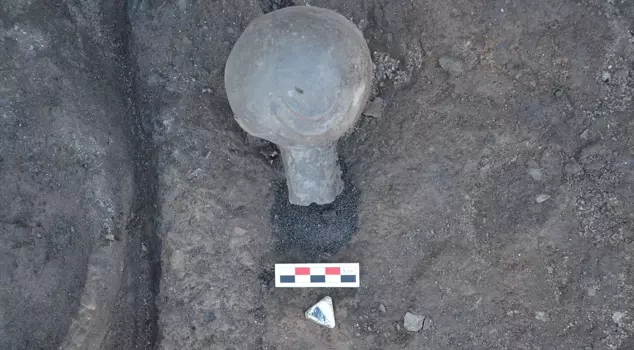
15.11.2024 17:30
In Kütahya, during a rescue excavation conducted at the mound located within the thermal power plant site, grains that had been preserved by burning were uncovered. It has been revealed that this discovery holds an economic value of 5,000 years for Kütahya.
Here is the translated HTML content with the text and the `title` and `alt` attributes of the `img` tags translated into English:
```html
The Seyitömer Mound, which dates back to 3000 BC, has a lignite reserve of 12 million tons beneath it, and the excavation aimed at bringing this reserve into the economy was first initiated in 1989, where poppy and chickpea seeds from the Bronze Age were discovered.
Kütahya Museum Director Sevgi Gürdal stated to AA correspondent that they are continuing the excavation work, which started in May, with a team of 25 expert personnel consisting of archaeologists, anthropologists, restorers, architects, architectural restorers, and ceramic specialists, along with a group of 50 workers.
This year, Gürdal noted that they are working in the Middle Bronze Age and Early Bronze Age layers, saying, "We focused primarily on the earliest layers of the Early Bronze Age, that is, the first settlements of the mound. During these studies, we obtained various information regarding the architecture of the mound, daily life, and agricultural products."
IN LOWER LAYERS, EACH HOUSE HAS ITS OWN WALL; IN UPPER LAYERS, WALLS ARE COMMON
Gürdal expressed that they encountered rectangular planned houses consisting of two adjacent rooms during the excavations, emphasizing that what is interesting in these houses is that although the houses are adjacent in the upper layers, they share common walls, while in the lower layers, each house has its own wall.
Gürdal explained that they also reached significant findings related to daily life, stating, "We uncovered all the ovens of the houses along with their hearths and various workbenches, with all their internal furnishings. Additionally, we found many kitchen items such as pots, jugs, and spoons, along with findings related to daily life, unbaked weights, and containers. This situation indicates that the spaces were used not only as houses but also as workshops."
"TAVŞANLI DISTRICT IS FAMOUS FOR ITS ROASTED CHICKPEAS"
Gürdal reported that they also unearthed agricultural products that shed light on the agriculture and nutrition of 5 thousand years ago.
Emphasizing that the most important findings of this year are 5 thousand-year-old poppies and chickpeas, Gürdal stated, "We uncovered examples such as wheat, lentils, chickpeas, and poppies. Among these, chickpeas are significant for the region because Tavşanlı district is famous for its roasted chickpeas. The poppy is very interesting. We found poppies in beaked jars and small pots. Poppy is a product with economic value for the Kütahya and Afyonkarahisar regions, which is still significantly used in the food and pharmaceutical industries today. We can concretely say that poppy and chickpeas have had economic value for Kütahya for 5 thousand years."
Sevgi Gürdal added that they found the poppies and chickpeas lined up in the pantry section of the structures, and due to the buildings having undergone a fire, these findings have survived to this day due to carbonization.
SEYİTÖMER MOUND
The Seyitömer Mound, which dates back to 3000 BC, is located 26 kilometers away from the city center, within the working area of Çelikler Seyitömer Electricity Generation Inc. The rescue excavation, which started in 1989 by the Eskişehir Museum Directorate to bring the lignite beneath it into the economy, has an original height of 26 meters, a width of 140 meters, and a length of 150 meters. The mound was excavated by the Afyonkarahisar Museum Directorate between 1990 and 1995.
In accordance with the protocol signed between the General Directorate of Turkish Coal Enterprises and the Rectorate of Kütahya Dumlupınar University (DPU), the excavations were transferred to the Archaeology Department of Kütahya DPU in 2006. The excavation team, consisting of faculty members, students, and workers, continued their work until 2014. More than 17 thousand artifacts unearthed from the mound were delivered to the Museum Directorate for exhibition. The rescue excavation has been carried out by the Kütahya Museum Directorate since 2019.
```
This translation maintains the original HTML structure while translating the text and the attributes as requested.